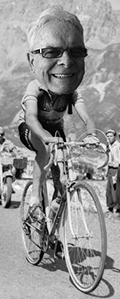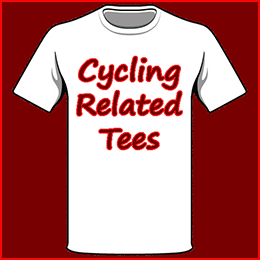Understanding other cultures
 Wed, April 16, 2008
Wed, April 16, 2008 
Probably one of the main causes of problems between the nations of the world is a failure to understand the difference in each other’s beliefs, customs, and general way of life.
When I wrote an article last September called “Womankind,” linking to a blog from Denmark called “Copenhagen Girls on Bikes,” I received a lot of criticism by way of comments.
In fact, the criticism is ongoing both for me and the Copenhagen blog.
Most of the critics are from America and label the site as sexist, voyeuristic, and demeaning to women. I have looked for, and not found complaints from Danish women. One would think if the women pictured on the Girls on Bikes blog found it offensive, they would at least protest by way of a comment or two.
On the other side of the coin, Mikael Colville-Andersen, one of the people responsible for Copenhagen Girls, in his effort to spread bicycle culture is often critical of American cyclists.
Known to speak out against the wearing of helmets and Lycra, he posted a comment on my recent post that highlighted a “California Cycling League Safety Video.”
This was his comment”
“That video is the work of the 'Vehics'. The Vehicular Cyclists are the Flat Earth Society of the cycling world. Strange, outdated beliefs with little science to back them up. I thought it was satire when I first saw it.”
I feel obliged to respond, and my reply is too long for a simple counter comment. Mikael, you are living in a country that has a definite bicycle culture; cyclists in America are riding their bikes, and doing the best they can, in a definite automobile culture. This is a left turn signal in Copenhagen. (Picture left.) In the US, it is entirely possible that the cyclist is not even seen, (We are invisible.) let alone such a nonchalant hand gesture.
This is a left turn signal in Copenhagen. (Picture left.) In the US, it is entirely possible that the cyclist is not even seen, (We are invisible.) let alone such a nonchalant hand gesture.
The cyclist must place themself in the center of the lane, forcing drivers to slow then give a clear signal and move over when it is safe to do so.
On my ride last weekend, I did this maneuver on a three-lane highway, taking one lane at a time, to get to the fourth left turn lane.
I doubt there are many such roads in Denmark, and if there are, I am sure there is special provision made for cyclists to turn safely.
I wore Lycra and my helmet. Bright colored Lycra because in the interest of my own safety, I want to be seen. A helmet because it is my choice; I view it, as a very last line of protection should all else fail. In addition, it keeps my head cool in the very hot climate here. The temperature in South Carolina where I live was 85 F. (29.4 C.) on Saturday, to ride in street clothes would not have been practical.
The picture at the top of this piece is of a woman riding at night in Copenhagen. Even though she is dressed entirely in black, she is safe and obviously feels she is safe. This would not be the case in any large American city, even on a bike equipped with good lighting.
Mikael, I admire what you are doing; spreading the word of a bicycle culture. However, I doubt your message is reaching mainstream America, and those it is reaching think your site is sexist, voyeuristic, etc. etc. (Probably in part because of mainstream America’s puritan culture.)
My advice would be, not to alienate the few fans you have in the US, namely the bicycle enthusiasts. I would love to see more people riding bikes to work than driving cars, but realistically this is not going to happen anytime soon in the US.
People ride bikes in Demark because it is the normal thing to do. The country is tiny compared to the US; distances traveled are much shorter. Riding a bicycle in America is not considered normal by the majority of the population, and the people riding bicycles in the USA are mostly enthusiasts, doing so for the love of riding a bicycle.
Let us all try to understand the differences in our separate cultures, and realize what works and is acceptable in one country, will not necessarily be the same in the other. I suspect the Danes do not view Copenhagen Girls on Bikes as sexist.
In the Scandinavian countries, there is more equality and tolerance for differences, not just between the sexes, but in all walks of life. Whereas, in the US there is a constant ongoing battle of the sexes, as well as intolerance for anyone seen as a little different and outside the mainstream.
And so Mikael, try to understand what it is like to be a bike rider in a car culture country. Vehicular cycling, far from being some weird science, is for the most part following the rules of the road. Ease up on the criticism; we are doing the best we can under very difficult conditions.
 Dave Moulton | Comments Off |
Dave Moulton | Comments Off | 

















Reader Comments (26)
Riding aggresively is often necessary to be an effective vehi-cyclist but such riding style is not preferred by my wife, children or friends from Europe. They prefer the extra space on roads typically provided by effective advocacy and Complete Streets. They'll ride on 8-lane wide streets but only with me asserting dominance as needed.
There is nothing wrong with being vehi-cyclists as long as other motorized vehicles honor STR. I look forward to that day and yes I greatly enjoy open-minded Copenhagen.
Jack
Whatever anyone says about helmets, segregation, vehic-yu-larity or any of scores of other safety stances, the greatest per-cyclist safety boon seems to simply be having more cyclists in the traffic mix per motorist. Any ideas beyond that always seem to come with almost as many side-effects and drawbacks as benefits.
An American cyclist riding American-style in Denmark will live a lot longer than a Dane riding Danish-style in America. I'm quite sad to say this, but that is how it is in a car-obsessed culture such as ours.
I saw him coming and knew he didn't see me, so I was completely stopped at the same time (in the intersection when he saw me which is why he screamed in surprise).
I just don't see how taking hands off the steering wheel made driving safer.
Just have to pay more and better attention than everyone else on the road I guess.
I think the topic directly relates to smart growth
I wish more girls would ride in the US like they do in Copenhagen. I would take tons of pics! (creepy, right?)
When it comes to cycling, some countries have all the luck.
RE: The Copenhagen Bike Blog ~~ I'm a woman and I love it! I wish I could cycle to work and in high heels.
"Suggestion, bicycle riders visiting or residing in another country MUST comply with applicable cycle regulations within that nation."
Please exercise caution while visiting South Carolina as injury may occur employing bicycle riding techniques common in other nations or states.
Recall, 'The Palmetto State' is NOT Canada nor Kansas!
Knowledge of accepted 'local' rules and regulations serves ALL parties well while typically enhancing your stay!
I enjoy your posts on proper street riding and my riding has improved as a result of the techniques I've learned. I commute in Washington DC and I've managed to give drivers fewer reasons to honk and yell. Hope to see more in this series...
I've commented on tolerance in Denmark before too. Mikael's comments seem highly intolerant and inflexible to me, and I've told Mikael this in public and in private emails. I still like him and his sites, but some of his criticisms of cycling in America indeed alienate many people. On the other hand, he's not too afraid of shooting off with the metaphorical mouth and saying what needs saying. Anyway, good post, Dave.
Dave, you might like this interview with Richard Schwinn (about a 26MB mp3 file) on steel in bike history as well as some of his perspective on bike history in the USA.
Finally, one last word about photos. In the US, it's legal to take a photo of someone in public. There is no expectation of privacy, though such photos cannot be used for advertising without the subject's consent. Editorial use is OK without consent.
Regardless, all the Copenhagen photos are taken from behind or off to the side. None of them confront the subject directly, looking her in the eye and asking for a photo. It gives these photos a voyeuristic, slightly creepy feel.
Craig
The other problem I have is their continual attack on spandex and racing. i agree that for a trip to the store I don't need special clothes, but when I am going on a 50 mile plus ride, their is equipment and clothes that work better, even if it is for fun. We don't expect to see people playing pick-up games of basketball in street clothes. And what really makes this interesting is that Europe is the home of competitive cycling.
On riding on the road, I say:
- Be assertive and make yourself visible!
On Copenhagen Girls on Bikes:
- It is great to see people expressing themselves with words and great photography.
On US X Europe cycling cultures:
- I am affraid we follow the US model in Australia.
Thanks!
"Copenhagen Cycle Chic"
The URL is
'CopenhagneGirlsOnBikes.blogspot.com".
The subtitle is important, and awesome:
"Bike Advocacy in High Heels"
Of the 14 comments you received on your original post, exactly two were of the "hate males" variety.
A third was very correct in blasting you - not hard enough, imo - for talking to women as if they were a bunch of imbeciles. Not sure what that's about. She went on to tell the comment creepster to 'stay away' - that's neither here nor there - just blog smack and smack-back.
So, does 2 "hate males" comments translate to 'a lot' of criticism, especially considering most of the rest of the 14 comments were overwhelmingly positive? Not a biggie, either way.
But - overall point is correct - USA is not Copenhagen, unfortunately.
p.s. i played in this as a youngin!
http://www.tivolicup.dk/
Regarding the VC's, what I object to is the anti-bike infrastructure sentiment. The claims that the bike lanes predominant in many European countries are 'dangerous' and that the only way forward is placing the bike right in middle of the traffic. Thus the Flat Earth Society comment.
When I posted a link to a page on their website in a post I recieved five emails within hours from loyal readers wondering why on earth I would link to them, all highlighting in no uncertain terms what they believe to be flawed in the movement.
To clear a couple of things up, there was a brief flurry of 'sexist remarks' back in our heyday when you wrote your piece. Haven't seen much since. Women account for half of the comments and the blog is regularly featured on fashion sites and in magazines, even in America. So that news is old news. :-) Time to move on.
I am anti-lycra, yes. Everyday urban cycling in regular clothes is a normal activity for millions of Europeans from Trondheim to Barcelona. Add even more Asians to the numbers. That's one of the things that Cycle Chic portrays.
Anti-helmet? No. A hasty label. Helmet advocacy is the greatest threat to bike culture, only outdone by helmet legislation. I merely try to highlight that helmets should be a voluntary, personal issue.
I'm not afraid of alienating my readers, so you shouldn't worry about that. 80% are in the States and I feel my regular readers are well acquainted with the wit and honesty I try to bring across on both Cycle Chic and Copenhagenize.com.
I have lived and cycled in several cities in America and Canada so I am well-acquainted with what it is like to cycle there. Which, if anything, only serves to cement my opinions. I've seen both sides of the coin like few others have.
You refer to Denmark, but if you read copenhagenize.com you'll learn that it isn't some strange aberration that we ride bikes so much. It's all over the continent. From Ferrara in Italy [31% of all trips by bike] to snowbound Vasteraas in northern Sweden [25% of all trips by bike]. To name but two.
While Denmark is a small country, Copenhagen is just as spread out as any American city of the same population. But enough about all that, I've already debunked these myths on my blogs.
The point is that Denmark isn't a fairytale land, nor is the Netherlands. In the 1960's there was little difference between a Danish city and an American one. Car-mad, the lot of us.
We changed it. Turned the tide. Built cycle infrastructure and bike culture out of the motor vehicle smog.
If that isn't an inspiration for American cities in 2008, then I don't know what is.
A European riding in the States wouldn't have that much of a problem. We ride defensively. Even on our wide, beautiful bike lanes, when a car or truck approaches an intersection and wants to turn, you'll see the 50 bikes ahead of you slow. Just in case. The guy in the car or a truck is a cyclist, too, so you know he'll stop to let the ongoing traffic continue on, but it's wonderful to see so many alert cyclists.
It comes with experience, of course.
Regarding that one comment about many of the shots from the back, you'll find the answers as to why on the blog. But sometimes it's just easier to fire off a comment without out actually checking up on things. .-)
As for you, Fritz. I forgive you. :-)
I, for one, am pleased that Jan Gehl, legendary urban planner, is hired by NYC and Seattle, with other cities on a waiting list, so that he can whip up some bike lanes and bike culture. If you build it, they will come. It's happening in car crazy Paris as you read this. And Barcelona, Sevilla, Berlin, Frankfurt, you name it.
Gene in Tacoma
-Kelly